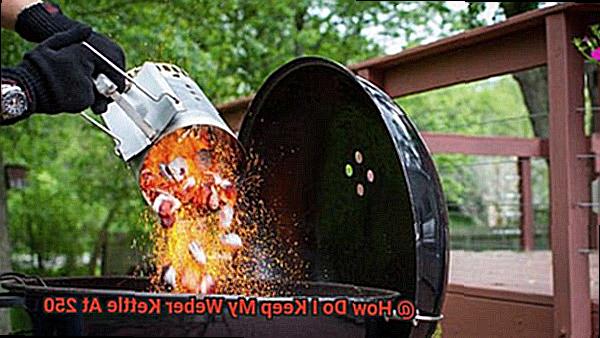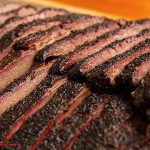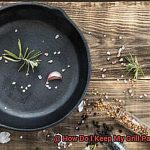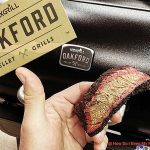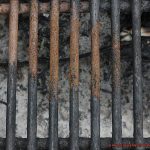Summer is here, and that means it’s time to fire up the grill and get cooking. But if you’re like most people, you know that getting your Weber kettle to stay at a steady 250°F can be a real challenge. After all, no one wants to bite into an unevenly cooked steak or dry chicken breast.
The good news is that with a few simple techniques and tricks, you can keep your Weber kettle at a consistent temperature for the perfect cook every time. From arranging the charcoal just right to maintaining proper airflow, there are several factors that can affect your grill’s temperature and cooking efficiency.
In this blog post, we’ll explore different ways of keeping your Weber Kettle grill at a constant 250°F. We’ll share expert tips and tricks, as well as some common mistakes to avoid along the way. With our help, you’ll be able to cook up mouth-watering brisket, ribs, or any other delicious dish with confidence and ease. So let’s dive in and master the art of temperature control on your Weber Kettle grill.
Contents
What is a Weber Kettle?
Introduced in the 1950s by George Stephen, a welder at the Weber Brothers Metal Works in Chicago, this grill has since become an iconic symbol of American outdoor cooking. The Weber Kettle is known for its lid, which was a revolutionary concept at the time of its introduction.
The most popular model of the Weber Kettle is the 22-inch kettle made of porcelain-enameled steel. The dome-shaped lid with a heat-resistant handle is designed to trap heat and smoke inside, infusing food with scrumptious flavors. The bowl-shaped base with a removable ash catcher makes cleaning up after use a breeze.
What sets the Weber Kettle apart from other grills is its versatility. It can be used for grilling, smoking, and even baking. With adjustable vents on the lid and base, you have complete control over the temperature and airflow inside the grill. You can keep your Weber Kettle at a consistent temperature of 250 degrees Fahrenheit, perfect for low and slow cooking.
Maintaining a consistent temperature in your Weber Kettle is essential for perfectly cooked meat. To achieve this, start by ensuring that the charcoal is evenly distributed around the perimeter of the grill. Once the coals have developed a white ash coating, adjust the vents on both the top and bottom to control airflow. Opening both vents will increase heat by allowing more oxygen into the grill, while partially closing them will decrease temperature.
To monitor temperature regularly, use a thermometer placed next to your meat. If you notice a drop in temperature, add more lit coals or adjust vents as needed. Using a water pan can also help maintain a consistent temperature by placing a foil-lined pan filled with water directly under the meat, which will also help keep it moist during cooking.
One crucial tip to remember is to avoid opening the grill lid too often, as this will release heat and disrupt the cooking process. Only open the lid when necessary to flip or check on the meat, and then quickly close it again.
Why is Keeping the Weber Kettle at 250 Degrees Important?
Grilling isn’t just about throwing some meat on the grill and hoping for the best – it’s a science, and one of the most critical factors is temperature control. Whether you’re a seasoned pro or just starting out, keeping your Weber Kettle at 250 degrees is a must if you want to achieve that perfect low and slow cook. But why is this temperature so crucial? Let’s take a closer look.
First and foremost, cooking at 250 degrees allows the meat to break down slowly, resulting in a texture that is tender, juicy, and simply divine. If the temperature is too high, the outside may cook too quickly while the inside remains undercooked, leaving you with tough and chewy meat that is less than appetizing. But at 250 degrees, the meat will cook gradually and evenly, resulting in a melt-in-your-mouth sensation that will have you craving more.
But it’s not just about texture – cooking at 250 degrees also allows for optimal flavor development. The low temperature allows the meat to absorb smoke and other flavors from wood chips or charcoal, resulting in a rich and complex taste that will impress even the pickiest of eaters. Whether you prefer a mild smoky flavor or something more intense, cooking at 250 degrees will give you the results you’re looking for.
Another benefit of cooking at a consistent temperature is food safety. When cooking at low temperatures like 250 degrees, it can take longer for meat to reach a safe internal temperature. However, by maintaining a steady heat throughout the process, you can ensure that your food is both delicious and safe to eat.
So how do you achieve that perfect 250-degree temperature? It’s all about control. By evenly distributing charcoal, adjusting vents to control airflow, using a water pan to regulate temperature, and avoiding opening the lid too often, you can maintain a consistent temperature throughout your cooking process. And with practice and patience, you’ll soon be a master at low and slow cooking.
Preparing the Charcoal for Grilling
If so, mastering the art of preparing charcoal for grilling in your Weber kettle is essential. The key to achieving a perfect low and slow cook at 250 degrees Fahrenheit is all in the charcoal preparation. So, let’s get into the nitty-gritty details of how to prepare your charcoal for grilling.
First and foremost, selecting high-quality natural charcoal made from natural materials is crucial. Cheap, chemically treated charcoal can spoil the flavor of your food, which is a big no-no. Once you’ve chosen your charcoal, it’s time to determine the amount you need based on your grill’s size and cooking time. For example, if you’re using a Weber kettle with a 22-inch diameter, you’ll require around 80 briquettes for two hours of cooking at 250 degrees Fahrenheit.
Now that you have the right amount of charcoal, it’s time to light it up. While lighter fluid is an option, we recommend using a chimney starter as it’s safer and doesn’t leave any chemical residue on the grill grates. Fill the chimney starter with the desired amount of charcoal and place some crumpled newspaper underneath. Light the newspaper and wait for the coals to ash over. This should take roughly 20-30 minutes.
Once your coals are hot and ready, spread them evenly over one side of the grill while leaving the other side empty for indirect heat cooking. This method gives you more control over the temperature and prevents flare-ups. Don’t forget to adjust the air vents to control the temperature. Initially, open them wide to allow maximum airflow, which will help raise the temperature quickly. Once it reaches 250 degrees Fahrenheit, partially close the vents to maintain this temperature.
In summary, preparing charcoal correctly is essential for maintaining a consistent temperature of 250 degrees Fahrenheit in your Weber kettle grill. To ensure this, choose high-quality natural charcoal, determine the amount needed based on your grill’s size and cooking time, use a chimney starter for safe lighting, and spread the hot coals evenly over one side of the grill. Finally, adjust the air vents to control the temperature and maintain it at 250 degrees Fahrenheit.
Adjusting the Vents to Control Temperature
Look no further than the art of adjusting vents on a Weber kettle grill. By mastering this essential skill, you’ll be able to achieve the perfect temperature for your low and slow cook every time.
Let’s start with the basics. A Weber kettle grill has two vents: the bottom vent, located at the bottom of the grill, controls the amount of air that enters the grill, while the top vent, located on the lid, controls the amount of air that exits. By adjusting these vents, you can control the temperature inside your grill.
To achieve a steady temperature of 250 degrees Fahrenheit, follow our expert recommendation: open the bottom vent approximately one-quarter of an inch and open the top vent halfway. This will allow for a consistent flow of oxygen to enter and exit your grill, keeping your charcoal burning at a steady temperature.
But what if your temperature starts to fluctuate? Don’t worry, we’ve got you covered. If the temperature rises above 250 degrees Fahrenheit, simply close the bottom vent slightly to reduce oxygen flow. If it drops below 250 degrees Fahrenheit, open the bottom vent slightly to increase oxygen flow. It’s all about finding that sweet spot that keeps your grill at a consistent temperature.
Keep in mind that adjusting vents may require some trial and error. Don’t be discouraged if it takes a few attempts to find that perfect temperature – practice makes perfect. Also remember that external factors such as wind and outside temperature can affect the temperature inside your grill, so adjust accordingly.
Monitoring the Temperature with a Thermometer
Attention all grill masters, temperature control is the key to achieving the perfect cook on your food. Whether you’re a novice or a seasoned pro, monitoring the temperature with a thermometer is crucial for maintaining consistent heat and achieving that delicious, mouth-watering flavor we all crave.
There are two types of thermometers available for grilling: digital and analog. While both can get the job done, digital thermometers are the preferred option due to their accuracy and ease of use. A digital thermometer typically has a probe that you insert into the meat or grill, which then displays the temperature on a clear digital screen. Analog thermometers, on the other hand, display the temperature using a dial and require manual calibration before use.
To monitor the temperature of your Weber kettle grill, you’ll need to place the thermometer probe in the cooking area. This allows you to keep track of the temperature throughout the cooking process and make adjustments if necessary. Keep in mind that different areas of the grill may have varying temperatures, so it’s important to check multiple locations with your thermometer.
In addition to checking multiple locations, keeping an eye on the temperature during the cooking process is essential. If you notice the temperature starting to drop or rise too much, it’s time to adjust those vents. By opening or closing the vents on your Weber kettle, you can increase or decrease airflow and raise or lower the temperature accordingly.
Here are some tips for maintaining steady heat:
- Use a digital thermometer for accuracy
- Check multiple locations on the grill
- Keep an eye on the temperature during cooking
- Adjust vents as needed to maintain consistent heat
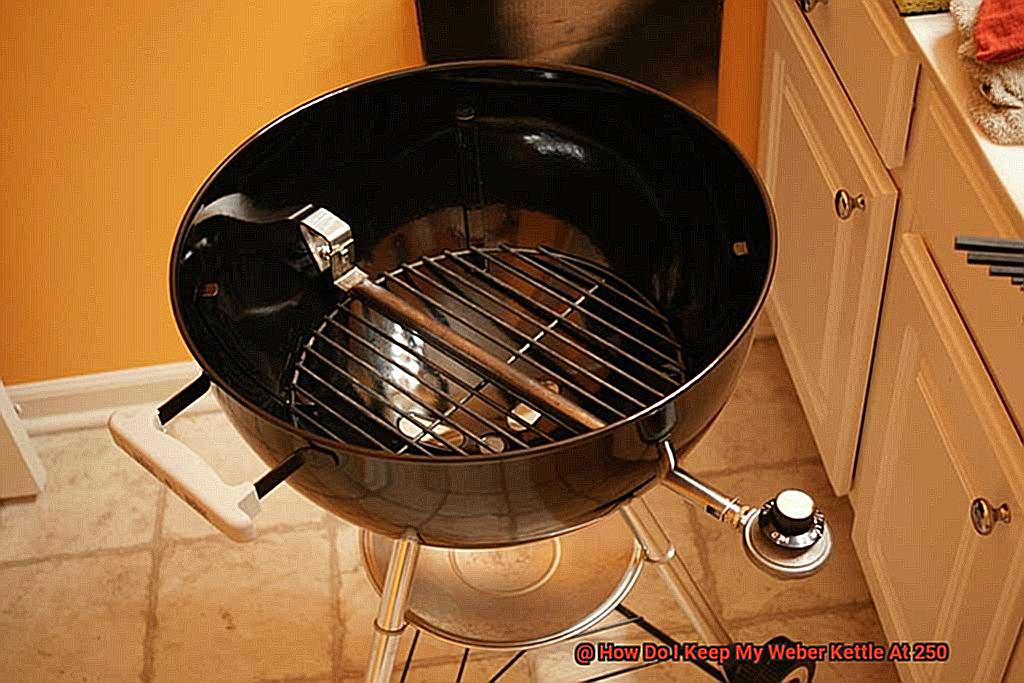
Using a Water Pan to Maintain Consistent Temperature
If you’re eager to elevate your cooking game and achieve succulent, perfectly cooked meats every time, look no further than the humble water pan. Not only does it help maintain a consistent temperature, but it also keeps your food moist and juicy.
To use a water pan on your Weber kettle, start by filling it with hot water and placing it directly under the food grate. The water acts as a temperature regulator, absorbing and releasing heat as needed. Keep an eye on the water level throughout the cooking process and top up with hot water as necessary.
This technique is especially helpful when cooking low and slow cuts of meat like brisket or pork shoulder that require hours of cooking time. By keeping the air moist, the water pan helps prevent your meat from drying out and becoming tough.
However, there is a potential downside to using a water pan: it can dilute the smoky flavor that many people crave in their barbecue. But fear not. You can still enjoy a deliciously smoky taste by adding other liquids to your water pan. Consider using beer or apple juice to impart additional flavor without sacrificing temperature regulation.
Avoid Opening the Grill Lid Too Often
When you open the lid, heat escapes and the temperature drops, which means you’ll need to use more fuel to keep the temperature steady. But fret not. By having a plan before you start grilling, preparing your food ahead of time, and using a good-quality thermometer, you can keep your lid closed and your temperature stable.
To minimize lid opening, ensure that everything you need is within reach before you start grilling. This will prevent you from needing to open the lid to grab tools or ingredients. Additionally, prepare your food ahead of time so that you can focus on cooking once the grill is hot. This will reduce the need for constant lid opening.
Another helpful tool is a good-quality thermometer. With an accurate thermometer, you can monitor the temperature inside the grill without having to open the lid. This means that you can adjust your vents or add fuel as needed without losing heat.
It’s also important to resist the temptation to check on your food too often. Every time you open the lid, heat escapes. Instead, trust your instincts and rely on cooking times and internal temperatures to determine when your food is done.
Additional Tips for Perfectly Cooked Meat
Achieving perfectly cooked meat is not as difficult as it may seem. With a few additional tips, you can become a grilling master in no time, especially when using your Weber kettle.
Tip #1: Use a Meat Thermometer for Accuracy
Investing in a quality meat thermometer is essential to ensure that your meat is cooked to perfection. This tool allows you to measure the internal temperature of your meat accurately. For instance, medium-rare steak should be cooked to an internal temperature of 130-135 degrees Fahrenheit.
Tip #2: Let Your Meat Rest Before Serving
After cooking your meat, let it rest for a few minutes before cutting into it. This gives the juices time to redistribute throughout the meat, resulting in a more tender and flavorful final product. A general rule of thumb is to let your meat rest for about 5-10 minutes before slicing.
Tip #3: Use the Two-Zone Cooking Method
The two-zone cooking method is perfect when using a Weber kettle grill. It involves creating two different heat zones on your grill. One side should be hot for searing, while the other side should be cooler for indirect cooking. This allows you to sear your meat for flavor and then finish cooking it over indirect heat for even cooking.
Tip #4: Avoid Overcooking Your Meat
Overcooking your meat can result in a dry and tough final product. Be sure to monitor the internal temperature of your meat and remove it from the grill as soon as it reaches the desired temperature.
Tip #5: Experiment with Different Cuts and Techniques
Different cuts of meat require different cooking methods and times. So, don’t be afraid to experiment with different cuts of meat and techniques. Whether you’re grilling up a juicy steak or slow-cooking some ribs, taking the time to perfect your method will result in a delicious end product every time.
Conclusion
In conclusion, the key to achieving succulent and tender meat on your Weber Kettle grill lies in mastering temperature control. By following the tips and tricks outlined in this article, you can keep your grill at a consistent 250°F, perfect for low and slow cooking that will have your taste buds dancing.
To achieve this temperature, it is essential to pay attention to several factors such as arranging charcoal correctly, maintaining proper airflow, and using a water pan to regulate temperature. Regularly monitoring the temperature with a thermometer placed next to your meat is also critical. Remember to adjust vents as needed to maintain consistent heat and avoid opening the lid too often.
Using high-quality natural charcoal, letting your meat rest before serving, experimenting with different cuts and techniques while avoiding overcooking are additional tips that will enhance your grilling skills.
With practice and patience, you’ll soon be able to cook up mouth-watering brisket, ribs or any other delicious dish with confidence and ease. So go ahead and light up that Weber Kettle grill.

